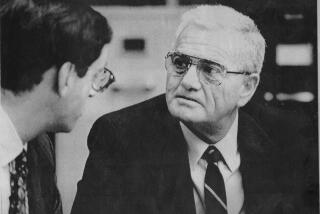Forensic genealogists shake family trees to find crime suspects
After a 79-year-old woman was raped in her own home, genetic genealogist CeCe Moore had to work fast. The assailant was still out there.
Her mind raced. “I have got to find him now, before he reoffends,” she thought.
“I felt like it was a life-or-death situation.”
Police had asked her to identify the rapist in the April attack in St. George, Utah. The idea was to plug his DNA into a public database and find his family tree. Maybe then they could deduce his name.
“I was sweating,” Moore said. “I felt like I was battling to get to the other side of a dark jungle just to solve that.”
Moore and her team quickly provided a name. Police soon arrested a suspect.
Moore, a graduate of Mt. Carmel High School in Rancho Peñasquitos, is one of the biggest names in genetic genealogy, which made national headlines in 2018 as a tool to help identify high-profile rape and murder suspects, most famously the suspected Golden State Killer.
Moore is recognizable from the PBS documentary show “Finding Your Roots with Henry Louis Gates Jr.,” in which she helps the Harvard scholar dig into the ancestry of celebrities and notables. She’s also become an expert in cases of people trying to identify their birth parents.
In 2016, her work was featured on ABC’s “20/20,” in which she figured out that three people who had been abandoned in Los Angeles as newborns in the 1980s all had the same mother.
Moore recently joined Virginia-based Parabon NanoLabs to lead its forensic genealogy unit. In September, the company said in a statement that it had solved 10 cases in the first 100 days of operation.
The field of genetic genealogy itself had a breakout year in 2018.
The method made its big-stage debut as a crime-solving tool in April with the announcement that it had been used to catch Joseph James DeAngelo, the suspected Golden State Killer, so named for a series of long crimes that included more than 50 rapes and at least 13 slayings throughout California from 1974 to 1986.
Here’s how it works: Police upload DNA from a crime scene into a public repository of DNA profiles and look for a potential match. If there is enough of a family connection between the crime scene sample and a profile in the database, a genetic genealogist like Moore might shake a name out of the family tree.
Moore has identified suspects in more than two dozen cases thus far.
“This is really just the beginning of genetic genealogy and law enforcement,” Moore said last month. “I knew the potential all along. I knew this was coming for a long time.”
Moore said that, in all the cases she has worked on, only once did the name she provided to police match someone already on their list of suspects.
Police don’t run out and make arrests based solely on the names genealogists provide. Once they have a name, the investigation continues.
“Really, we are just giving them a highly scientific tip,” Moore said.
In Carlsbad, that kind of tip solved a cold case.
Finding a Carlsbad killer
Barbara Rae-Venter, the genetic genealogist who helped crack the Golden State Killer case, is retired after a career as a patent attorney. This new line of work “is a hobby,” she told the San Diego Union-Tribune in November.
Her hobby also provided some answers for a Carlsbad family who lost a daughter to a killer on Valentine’s Day 2007.
Jodine Serrin, 39, was developmentally disabled but highly functioning and lived in an apartment not far from her parents’ home. Nearly 12 years ago, the Serrins stopped by the apartment and found their daughter naked and beaten to death in her bed.
After Rae-Venter identified DeAngelo as the suspect in the Golden State Killer case, Carlsbad police turned to her for help in their case. Rae-Venter took the DNA evidence from the crime scene and traced it to an Oceanside man as the most likely assailant.
The suspect, who was 38 at the time of Serrin’s death, had taken his own life in 2011.
Before Rae-Venter’s work on the case, detectives “did not have somebody to look at” as a potential suspect, Carlsbad police Lt. Greg Koran said in November.
It’s the first known case in the San Diego area solved using genetic genealogy.
Teasing out a killer’s name
Do-it-yourself genetic testing has become popular over the last few years. Companies like Ancestry or 23andMe offer kits that can be ordered online. Users swab the inside of a cheek and seal the swab in a tube, then mail it in to the company for testing.
The companies then analyze the samples and provide the customer with a profile of their DNA.
The consumer sites do not upload DNA information into the public databases, and they do not work with police.
But customers, if they choose, can upload their DNA profile to a public database — GEDmatch, created by citizen scientists, is the biggest.
Once their profiles are uploaded, people can search for relatives who share parts of their profile. GEDmatch’s terms of service make it clear that the information is also available to police investigating violent crimes such as rape or murder.
Genetic genealogists use DNA evidence to build out family trees, working backward through genealogical records to find ancestors of customers who share genes with a criminal suspect. A third-cousin match, for example, means the two people share a great-grandparent, providing a crucial link that can be used to find other descendants of that shared ancestor.
What about privacy?
For all its fans, genetic genealogy is still very new as a forensic tool. There is no formal training or certification for this job. It’s not yet courtroom-tested. It’s controversial.
And then there are concerns about privacy and civil rights.
This year, an ACLU attorney argued in the Washington Post that uploading DNA from a crime scene into a public database might have violated DeAngelo’s privacy rights.
“People may not be so troubled by such an intrusion when it comes to a serial killer,” attorney Vera Eidelman wrote, “but imagine the implications of using this technique for shoplifters or trespassers.”
None of the arrests in DNA genetic genealogy cases throughout the country have made it to trial, but at least one has ended with a guilty plea.
In Indiana last month, a man admitted that he abducted, raped and killed an 8-year-old Fort Wayne girl in 1988. John D. Miller was sentenced to 80 years in prison.
Moore and the team she leads at Parabon NanoLabs had identified him.
‘There won’t be Golden State Killers’
Moore says she has helped solve more than two dozen cases, including two in which the suspect was still active. Those are the priority.
“They are going to go to the head of the list of the 100 or so cases that we have waiting,” Moore said. “If we can save a life or keep a woman from being raped, it will be worth it.”
And that was why she had sleepless nights while working to identify the suspect in the rape of the 79-year-old woman in Utah.
“If it starts being used earlier in the investigations, there won’t be Golden State Killers,” Moore said. “There won’t be long-career criminals, because we are going to catch them much faster.”
Figueroa writes for the San Diego Union-Tribune.
More to Read
Sign up for Essential California
The most important California stories and recommendations in your inbox every morning.
You may occasionally receive promotional content from the Los Angeles Times.











